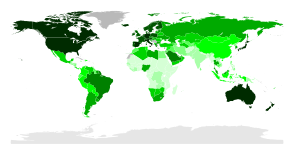
Urban land use is often dominated by automobiles. Pictured:
São Paulo,
Brazil.

World map of automobiles per capita.
Over the course of the 20th century, the
automobile rapidly developed from an expensive toy for the rich into the
de facto standard for passenger
transport in most developed countries.
[1] In developing countries, the effects of the automobile have lagged, but are emulating the impacts of developed nations. The development of the automobile built upon the transport revolution started by
railways, and like the railways, introduced sweeping changes in employment patterns, social interactions,
infrastructure and goods distribution.
The effects of automobiles on everyday life have been a subject of controversy. While the introduction of the mass-produced automobile represented a revolution in mobility and convenience, the modern consequences of heavy automotive use contribute to the use of
non-renewable fuels, a dramatic increase in the rate of
accidental death,
social isolation and the disconnection of community, rise in
obesity, the generation of
air and
noise pollution, and the facilitation of
urban sprawl and
urban decay.
[2]

